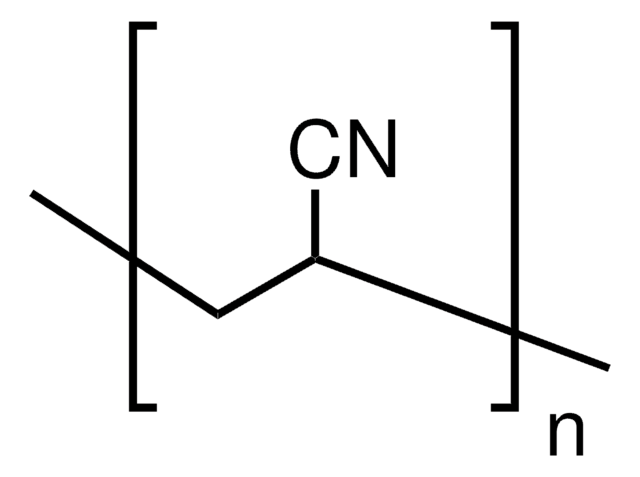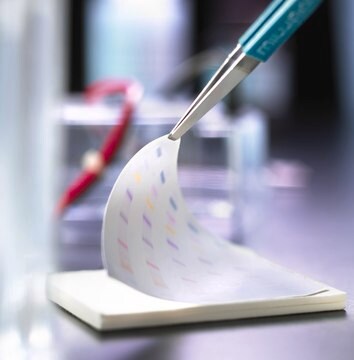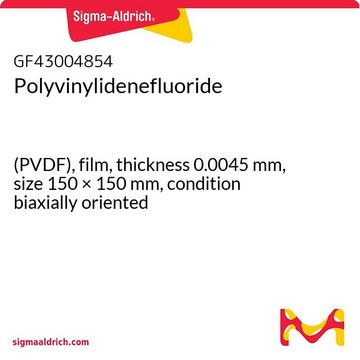182702
Poly(vinylidene fluoride)
average Mw ~534,000 by GPC, powder
Sinonimo/i:
PVDF
Autenticatiper visualizzare i prezzi riservati alla tua organizzazione & contrattuali
About This Item
Formula condensata:
(CH2CF2)n
Numero CAS:
Numero MDL:
Codice UNSPSC:
12162002
ID PubChem:
NACRES:
NA.23
Prodotti consigliati
Tensione di vapore
15 mmHg ( 32 °C)
Livello qualitativo
Stato
powder
PM
average Mw ~534,000 by GPC
Indice di rifrazione
n20/D 1.42
Temp. transizione
Tg −38 °C
Tm 171 °C
Densità
1.74 g/mL at 25 °C
Stringa SMILE
FC(F)=C
InChI
1S/C2H2F2/c1-2(3)4/h1H2
BQCIDUSAKPWEOX-UHFFFAOYSA-N
Cerchi prodotti simili? Visita Guida al confronto tra prodotti
Categorie correlate
Descrizione generale
Poly(vinylidene fluoride) PVDF is a semi crystalline non-centrosymmetric polymer which exhibits piezo-, pyro- and ferroelectric properties. It is a linear polymer that shows permanent electric dipoles perpendicular to the direction of the molecular chain. These dipoles result from the difference in electronegativity between the atoms of hydrogen and fluorine with respect to carbon. Depending on the processing conditions, PVDF exhibits several different crystalline phases (α,β,γ,δ). The β phase of PVDF is the phase that exhibits the best ferroelectric and piezoelectric properties.
Applicazioni
Poly(vinylidene fluoride) (PVDF) is used in nanoporous electrodes. It is used to synthesize composites comprising of ultrafine fibers of PVDF embedded with carbon nanotubes. It can be used in sensors, actuators, for energy storage, sphygmomanometers, pressure sensors and nanogenerators, lithium ion batteries. Additionally, it may find application as matrix for PVDF-nanoclay nanocomposites and PVDF acrylic rubber/clay nanocomposite hybrid.
Codice della classe di stoccaggio
11 - Combustible Solids
Classe di pericolosità dell'acqua (WGK)
WGK 3
Punto d’infiammabilità (°F)
Not applicable
Punto d’infiammabilità (°C)
Not applicable
Dispositivi di protezione individuale
Eyeshields, Gloves, type N95 (US)
Scegli una delle versioni più recenti:
Possiedi già questo prodotto?
I documenti relativi ai prodotti acquistati recentemente sono disponibili nell’Archivio dei documenti.
I clienti hanno visto anche
Mohammad Mahdi Abolhasani et al.
PloS one, 9(2), e88715-e88715 (2014-02-20)
In this paper, intercalation of nanoclay in the miscible polymer blend of poly(vinylidene fluoride) (PVDF) and acrylic rubber(ACM) was studied. X-ray diffraction was used to investigate the formation of nanoscale polymer blend/clay hybrid. Infrared spectroscopy and X-ray analysis revealed the
Hot Plate Annealing at a Low Temperature of a Thin Ferroelectric P(VDF-TrFE) Film with an Improved Crystalline Structure for Sensors and Actuators.
Sensors (Basel, Switzerland), 14(10), 19115-19127 null
Chi Yan Lai et al.
Membranes, 4(1), 55-78 (2014-06-25)
Current commercial polymer membranes have shown high performance and durability in water treatment, converting poor quality waters to higher quality suitable for drinking, agriculture and recycling. However, to extend the treatment into more challenging water sources containing abrasive particles, micro
Wenzhong Ma et al.
Membranes, 4(2), 243-256 (2014-06-25)
The crystallization behaviors of two copolymers of PVDF were studied, and the effect of copolymerized chains on the crystallization behavior was investigated. The results indicated that both copolymers had a lowered crystallization temperature and crystallinity. The crystallization rate was improved
Thermal-to-electric energy conversion of a nanoporous carbon
Yu Q, et al
Journal of Power Sources, 183(1), 403-405 (2008)
Global Trade Item Number
| SKU | GTIN |
|---|---|
| 182702-100G | 4061838252227 |
| 182702-250G | 4061838755926 |
| 182702-5G | 4061838755933 |
Il team dei nostri ricercatori vanta grande esperienza in tutte le aree della ricerca quali Life Science, scienza dei materiali, sintesi chimica, cromatografia, discipline analitiche, ecc..
Contatta l'Assistenza Tecnica.






